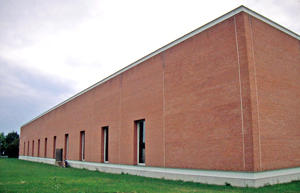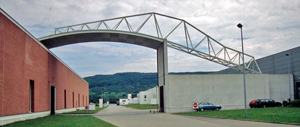 |
 |
 |
 |
 |
 |
| |
 |
|
 |
 |
 |
  |
  |
 |
 |
 |
 |
|
|
 |
|
 |
 |
 |
BUILDING |
 |
|
 |
|
 |
 |
 |
| |
 |
| 
 |
Vitra International Furniture Factory
|
|
 |
 |
 |
 |
DESIGNER |
 |
|
|
 |
|
 |
 |
 |
| |
 |
|
 |
 |
 |
 |
DESCRIPTION |
 |
|
|
 |
|
 |
 |
 |
|
|
 |
 In May 1991 it was decided that the next building on the Vitra site, a hall for metal manufacturing, was to be the work of Alvaro Siza. An important factor in this decision was the expectation that Siza would react brillantly to the increasing multiplicity of the Vitra complex. The brief was to design the largest building on the site. In May 1991 it was decided that the next building on the Vitra site, a hall for metal manufacturing, was to be the work of Alvaro Siza. An important factor in this decision was the expectation that Siza would react brillantly to the increasing multiplicity of the Vitra complex. The brief was to design the largest building on the site.
To the exterior, Siza's hall is oriented on the busy federal highway. Looking inward toward the Vitra site, the hall takes its bearings from its immediate proximity to buildings by Frank O. Gehry, Nicholas Grimshaw, and Zaha Hadid. Originally a small office building was also planned but at the beginning of 1992 this idea was scrapped in favor of a larger factory surface. Too, in May 1992, changes in site design were added to accommodate parking space for 400 cars and an entrance area. This strictly defined program left less room for play than other Vitra buildings had been given. Reduction, always a complex and difficult task, made this project a great challenge.
Siza's factory, the first and largest building he has realized, is a brick building. With its concentration on essentials, it is reminiscent of nineteenth-century industrial architecture. Seen from outside the Vitra complex, the most typical view of the building is from automobiles passing by on the highway. Therefore Siza placed a nearly closed monumental wall made of unglazed red brick on the street side. Two horizontal steel bands enclose the wall at its peak and above its granite base. With brick as a fourth prominent material, Siza creates a conscious contrast to the facades of neighboring buildings in white plaster (Gehry), aluminium (Grimshaw), and concrete (Hadid).
 The problematic difference in scale between the large factory hall and the small fire station by Zaha Hadid located only a few meters away is countered by the peacefulness of Siza's facades that work as backdrop to the sculptural qualities of the fire station. The problematic difference in scale between the large factory hall and the small fire station by Zaha Hadid located only a few meters away is countered by the peacefulness of Siza's facades that work as backdrop to the sculptural qualities of the fire station.
 With the arch that bridges the distance between Siza's hall and the Grimshaw building, the architect makes a powerful symbolic gesture for the Vitra site. His task was to create a protective roof for the traffic between the two buildings. The problem here was that any connection placed straight across the space in the usual height of four to five meters would have blocked the view of Hadid's fire station. Siza chose an 11-meter high, steel load-bearing structure from which a roof element and its support form an optical frame for the fire station. This construction is anchored so as not to come into contact with the roof of Siza's building. With the arch that bridges the distance between Siza's hall and the Grimshaw building, the architect makes a powerful symbolic gesture for the Vitra site. His task was to create a protective roof for the traffic between the two buildings. The problem here was that any connection placed straight across the space in the usual height of four to five meters would have blocked the view of Hadid's fire station. Siza chose an 11-meter high, steel load-bearing structure from which a roof element and its support form an optical frame for the fire station. This construction is anchored so as not to come into contact with the roof of Siza's building.
Inside the hall Siza has created two highly varied autonomous buildings. One is reminiscent of Gehry's gateway and, simultaneously, of a small modest house from the local southern German environment. This building contains the superintendent's office and restroom facilities. The other building, an elegant technical direction stand on four columns, looks like a UFO amidst the large machines that surround it. Siza also intervenes in those areas at which the scale of the building changes: at doors, stairs, in the lounge, and on the terrace.
Outside, Siza designed the parking area on a remnant piece of land bordered by the highway mentioned above and an imaginary factory building to be constructed at a later date. The architect organized the space and created two staggered square zones connected by a field of granite slabs corresponding to the connecting employee entrance which is marked by two upright granite blocks.
Edited by Vitra |
|
 |
 |
 |
 |
 |
 |
 |
MATERIALS |
 |
|
|
 |
|
 |
 |
 |
 |
 |
|
reinforced concrete, steel, granite, sheet Exterior walls
reinforced concrete skeleton with limestone/sandstone inner masonry, outer ancillary shell in clinker block
Base
Portugese granite
Factory roof
steel construction, tin cladding
Connecting element
steelframe construction lowering device: aluminium coated steel beams, electrical hoist
Windows
steelframe with insulation glass
Floor
industrial concrete
|
|
 |
 |
 |
 |
LOCATION |
 |
|
|
 |
|
 |
 |
 |

|
 |

|
Continent |
|
 |
|
Nation |
|
 |
|
Land |
|
 |
|
District |
|
 |
|
Town |
|
 |
|
Neighborhoods |
|
 |
|
Address |
|
 |
|
|
|
 |
|
 |
 |
 |
 |
MAP |
 |
|
|
 |
|
 |
 |
 |
| |
 |
|
 |
 |
 |
 |
|
TYPOLOGY |
 |
|
|
 |
|
 |
 |
 |
Main |
 |
|
 |
ARCHITECTURE | Industrial buildings and plants
Firms, factories, workshops
| |
|
|
 |
|
Additional |
 |
|
 |
ARCHITECTURE | Transport buildings and structures
Garages, car parking, etc.
| |
 |
 |
 |
 |
CHRONOLOGY |
 |
|
|
 |
|
 |
 |
 |
Project |
 |
|
 |
| 
 |
1991
|
|
Realisation |
 |
|
 |
| 
 |
1992 - 1994 |
|
 |
 |
 |
 |
BIBILIOGRAPHIC REFERENCES |
 |
|
|
 |
|
 |
 |
 |
|
 |
| Fabrizio Carloncelli, "Álvaro Siza Vieira. Vitra International Furniture Factory", Materia 32, maggio-agosto/may-august 2000 [Architettura dei luoghi di lavoro/Architecture of workplaces], pp. 26-35 |
|
|
| Architectural Guide. Basel 1980-2000, Birkhaüser, Basel 2000, n. 99 |
|
|
| Kenneth Frampton, Álvaro Siza. Tutte le opere, Electa, Milano 1999, pp. 444-450 |
|
|
| Pedro de Llano, Carlos Castanheira (ed.), Álvaro Siza. Opere e progetti, Electa, Milano 1995, pp. 156-159 |
|
|
"Vitra. Ando, Gehry, Hadid, Siza", Lotus international 85, maggio/may 1995 [Dopo il Guggenheim/After the Guggenheim], "Vitra" pp. 74-99
Matthias Ackermann, "Figure di artisti alle porte della fabbrica/Figures of Artists at the Gates of the Factory", Lotus international 85, maggio/may 1995 [Dopo il Guggenheim/After the Guggenheim], "Vitra" pp. 74-99
"Stabilimento produttivo/Production Plant. Alvaro Siza", Lotus international 85, maggio/may 1995 [Dopo il Guggenheim/After the Guggenheim], "Vitra" pp. 90-93 (74-99) |
|
|
| El Croquis 68/69, 1994/IV [Alvaro Siza Vieira. 1958-1994], pp. 214-221 |
|
 |
 |
 |
 |
 |
 |
 |
CLIENT |
 |
|
|
 |
|
 |
 |
 |
| |
 |
| Rolf Fehlbaum, Vitra GmbH, Weil-am-Rhein |
|
 |
 |
 |
 |
DIMENSIONAL
DATA |
 |
|
|
 |
|
 |
 |
 |
| Surface |
 |
|
 |
|
| Volume |
 |
|
 |
|
 |
 |
 |
 |
STRUCTURES |
 |
|
|
 |
|
 |
 |
 |
| |
 |
|
 |
 |
 |
 |
STAFF |
 |
|
|
 |
|
 |
 |
 |
|
 |
|
Design |
 |
|
Project architect |
 |
|
Associate architect |
 |
Architekten GPF & Assozierte
Gunter Pfeifer, Roland Mayer |
|
Project leader |
 |
| Salomé Grisard, Wolfgang Mehnert, Bernhard Vester |
|
Design team |
 |
| Christian Castanheira, Cecilia Lau, Clemente Menéres Semode, Luis Diaz Mauriño, Rudolf Finsterwalder |
|
 |
 |
 |
 |
RELATED PROJECTS |
 |
|
|
 |
|
 |
 |
 |
| |
 |
|
 |
  |
 |
|
|